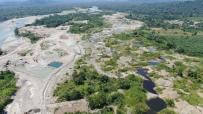
A 40-meter and 40-ton shihuahuaco tree can take up to 500 years to reach this size, but a man needs just an hour to cut it and take it away from the Amazon forest. The density of its wood makes it impossible to be transported down the river, as is the case with the logs of other species, which are sent floating to sawmills located near the banks of the nearest cities, such as Pucallpa or Iquitos, the two most important timber collection centers in the Peruvian Amazon. To extract centenary specimens of shihuahuaco it is necessary to cut forests and open roads.
The global demand for this longstanding hardwood tree has long made it one of the most extracted species from forests from 2010 to 2020. Compendiums from the National Forest and Wildlife Service (SERFOR) show that in ten years at least 353,310 shihuahuaco trees were removed. This means 1’625,227 cubic meters of wood (m3). The common name of shihuahuaco refers to six species, but three are the most commercial: dipteryx odorata, dipteryx micrantha and coumaroun odorata. But this Amazonian giant is not the only tree threatened.
Tornillo (cedrelinga cateniformis) can reach a height of 45 meters along hundreds of years. Riverbanks are their favorite places to grow. Therefore, finding one and logging it is easier than removing other species which grow in more rugged areas of the forest. Tornillo plays an important ecological role in the Amazon, as its large roots fix nitrogen to the soil and enrich the land around it, to be used by other plants.
COMMERCIAL PRESSURE ON THE LARGEST AND LONGEST-LIVED TREES IN THE AMAZON HAS MADE THEM THE MOST FELLED AMAZONIAN SPECIES".
From 2010 to 2020, 379,302 tornillo trees were officially cut; this means 1’744,791 m3 of their wood. The global demand for Amazonian wood also involves other species. Between 2010 and 2020 the most felled trees, besides shihuahuaco and tornillo, were cumala, lupuna, cachimbo, capinuri, capirona, bolaina and copaiba.
The recent Tropical Timber Study 2050 sets a scenario of high pressure on tropical forests. According to this document, in a rather conservative context, total world production of roundwood will increase by 13% in 2050, to reach 4,300 million m³. “A doubling of global resource consumption by 2050 would likely exceed global sustainable supply and result in negative impacts on biodiversity, climate, ecosystems and human wellbeing,” expressed one of the authors, Christian Held, in the report.

CUTS IN THE FOREST. Between 2010 and 2020 alone, 379,302 tornillo trees and 353,310 shihuahuaco trees were officially cut.
Photo: OjoPúblico / Marco Garro
In the Peruvian Amazon, this massive demand for resources results into the permanent removal of trees, often from unauthorized areas. And this happens while various specialists request that the list of threatened forest species is reviewed and new ones, such as shihuahuaco, are incorporated.
To understand which trees and species are the most under pressure, OjoPúblico analyzed the production history of roundwood (wood in its natural state, after being cut) from the Amazon forests of Peru in the last 10 years. Data show that tornillo and shihuahuaco top the national timber extraction list since 2019. This situation happens after the decline in production of species such as cumala, ishpingo and capinuri, which began to disappear from official figures after a period of heavy exploitation.
Tatiana Espinosa Quinones, executive director of NGO Arbio, has been engaged in a special way to the study of shihuahuaco. The institution he manages is concerned with the conservation of a thousand hectares of forest in the basin of Las Piedras River, in Madre de Dios, one of the most biodiverse Amazonian regions of the country. Studies conducted in this concession estimate that 68% of all shihuahuaco trees in this area are more than 500 years old and 16% are more than 1,000 years old.
The main problem of over-exploitation of shihuahuaco is that its extraction is not sustainable, Espinosa Quinones indicates. The annual growth rate of this species is one millimeter and, after 200 years, it decreases. For a shihuahuaco tree to reach a diameter of one meter, it takes about 700 years, according to studies by NGO Arbio.
Trade pressure on shihuahuaco and its slow growth are some of the reasons why since 2015, several specialists and institutions have requested that the National Forest and Wildlife Service (SERFOR) include it in the classification of threatened species of wild flora. However, as OjoPúblico has explained in previous, this list has not been updated since 2006.
Regarding tornillo, Eloy Cuellar Bautista, director of the department of forest management of Universidad Nacional Agraria La Molina, argues that the reduction in the population of this species is noticeable. “When I worked at INIA [National Institute of Agrarian Innovation] in 1974, we found eight tornillo trees per hectare; in 2014 inventory, one tornillo tree was found every eight hectares. The average permanence rate is very poor. It is only being removed and there are no conditions to replenish or reestablish it in the environment,” said Cuéllar Bautista, an expert in forestry, plantations, and agroforestry.
VITAL. Tornillo plays an important ecological role in the Amazon, as its roots fix nitrogen to the soil and enrich the land around it.
Illustration: OjoPúblico / Claudia Calderón.
The intensive exploitation of cumala
The cumala (albidiflora ferrule) is another of these centenary trees threatened by over-exploitation. This species tends to prefer the Amazonian plain rather than the mountain forests, so its population is distributed mainly in lowland forests. It can live up to 100 years and measure more than 30 meters. Although it is not one of the highest in the Amazon, its fruits serve as food to toucan and parrot species.
Most mature trees of this species are disappearing, according to records from the report of the National Forest and Wildlife Inventory of Peru, prepared by SERFOR in 2019.
In the period 2010 to 2020, 1’570,452 cubic meters of cumala wood was cut, corresponding to 341,402 trees according to the criteria to calculate the loss of forest cover established by OSINFOR. Its wood is appreciated in the market to manufacture panels and sheets for interiors.
The intensive exploitation of this tree, as with the others, has made it increasingly difficult to find one in the forests. The results of the first panel of the National Forest Inventory warn that in the low forest only young trees of virola albidiflora with a diameter of 20 to 29.9 cm have been found, with no records above that size, so “it is important to consider the need to incorporate measures to guarantee the conservation of the species".
Young trees are called fustals, and they are like a 20-year-old, explains Jorge Alvarez Melo, professor at Universidad Nacional Agraria de la Selva, to OjoPúblico. “When a seed finds favorable temperature, humidity, and soil conditions, it begins to germinate, and the planting is born. The it grows and becomes a seedling, which is comparable to a young child. It continues to develop and becomes a sapling, similar to a teenager. Over time it becomes a pole," says the specialist in forest resource conservation.
FOOD. Although it is not the tallest tree in the Amazon, the cumala fruits are food for species of toucans and parrots.
Illustration: OjoPúblico / Claudia Calderón.
A wood species reaches maturity when its circumference has reached a certain size established by forest authorities. This measure, in the timber business, is known as the minimum cut diameter and is different for each species.
In the low forest there are only young cumala trees that have not yet reached the minimum height for felling because most of the adults have already been cut down.
Unfortunately, cumala species are not the only ones in danger of disappearance; other timber trees in the Amazon are impacted by overexploitation.
The scarcity of lupuna, ishpingo and cachimbo
Lupuna (ceiba pentandra) is also known as palo algodón (cotton candy), because its shape resembles the sweet formed by threads of sugar, it has a straight trunk that ends in a cup shaped like a balloon. Once a year, this species sheds its mantle of leaves and renews it with clusters of white flowers, which then turn into cotton-like flakes. It is a giant among the other trees, as it can reach 70 meters high and its trunk reach up to 2.5 meters in diameter. It lives hundreds of years and is a source of food for wild species.
Its wood is used for making furniture and is therefore in great demand in the international market. Under the common name of lupuna, three other species are grouped: ceiba lupuna, ceiba samauma and chorisia integrifolia. It is the fifth species with the highest production from 2010 to 2020. According to SERFOR records, 1’255,359 m3 of roundwood, the equivalent of 272,904 trees, was extracted during this period. But the presence of lupuna in logging rankings dates back to the 90.
Over the decades, the amount of lupuna timber extracted has been declining. In 2008 there was a peak extraction of 188,396 m3 and in 2020 one sixth of that figure (30,222 m3). Eloy Cuéllar Bautista, of Universidad Nacional Agraria La Molina, explained OjoPúblico that when this happens, it may mean that the timber businesses no longer find the species in the field and therefore its production decreases. "There are more than 4,200 tree species in the Amazon. Around 600 have been identified, but with commercial value there are some 60, of which no more than 10 have the greatest commercial pressure,” he mentioned.
THE AMOUNT OF LUPUNA WOOD EXTRACTED HAS BEEN DECLINING. IN 2008 THERE WAS A PEAK EXTRACTION OF 188,396 M3 AND IN 2020 OF ONE SIXTH OF THAT FIGURE".
In fact, the National Forest Inventory indicates that lupuna is in critical condition, since only poles of 20 to 29.9 cm in diameter have been found. “Lupuna has a small population of juvenile and adult individuals. This type of behavior reveals a declining population and does not guarantee the perpetuity of the species,” the report points out.
Cuellar Bautista indicates that there is a lack of good forestry management in the country. “The weakness in the system is that there are no good plans to replace the trees being removed. In Peru there are no real forest businesses; we are mostly extractivists, and trees are expected to reproduce by themselves, when it is very difficult for a tree to grow in an environment like the jungle," he said.
The expert warns that when a species begins to disappear from the Amazon, businessmen look for others. This happens with lupuna, but also with ishpingo, a 40-meter high tree that went from being one the most cut species during the 80s and 90s to have zero presence in the production of the new millennium. In 1993 and 1995, more than 170 thousand m3 of roundwood were extracted; in 2020, only 6 thousand m3.
If we review the timber species extracted from the 90s to the present, you will notice that ishpingo began to disappear from the timber extraction tables since 2008. This species is disappearing quietly, after decades of excessive exploitation.
WHEN A SPECIES BEGINS TO DISAPPEAR FROM THE AMAZON, ENTREPRENEURS LOOK FOR OTHER ONES. THIS IS THE CASE WITH LUPUNA, BUT ALSO WITH ISHPINGO".
“Some time ago mahogany, cedar, ishpingo were extracted. They finished with them in the most accessible areas and they started with other species like tornillo, shihuahuaco, moena, cumala and capinuri”, adds Jorge Alvarez Melo, of Universidad Nacional Agraria de la Selva.
The cachimbo (common name of 8 tree species) ranks sixth among the most extracted species from 2010 to 2020. This tree is abundant in Loreto and reaches a height of 40 meters. AS their woods look similar, it is used by some businessmen to fake tornillo.

EXTRACTED. Peruvian law establishes that forestry concession companies must replace the felled tree by planting others, but specialists consulted mention that this does not happen, and when it does, it is insufficient.
Photo: OjoPúblico / Marco Garro
Questions on the standards and auditing
In the country, the extraction of trees for timber is regulated by the Forestry Ley Forestal y de Fauna Silvestre (Forestry and Wildlife Law). This standard establishes a 40-year concession period for areas used for wood extraction. During that time, businessmen can only complete up to two cutting cycles on the same plot. The trees harvested are those that have exceeded the minimum cutting diameter, a measure established by the forestry authorities which indicates the maturity of the wood.
Every concession must have a management plan, approved, and audited by national and local governments. This plan states that 20% of seed trees must be left on the concession to replenish the resource. In spite of these standards, specialists consulted for this report point out that they are not sufficient to guarantee the replacement of the extracted trees. An example of this is the alarming decrease of mature trees of timber species such as lupuna, cumala, and ishpingo.
Cuellar Bautista explains that in the case of seed trees, the regulation establishes that the tallest trees with the best seeds should be left standing. However, these trees have a high commercial value, so they are extracted and, for the most part, businessmen choose to leave trees with defects: “they leave the trees with imperfections, and the seeds of these new trees will have the same problems."
The activity to recover harvested species must be more active, it is not enough to wait for seeds to fall from trees. Hundreds of planting can grow under a seedling, but in a few months most will have died. For a seed to become a pole in the Amazon, favorable conditions are required, Cuellar Bautista mentioned.
In turn, Alvarez Melo indicates that the climate of the forest is favorable to the growth of plants, but “there is tremendous competition”. In each cycle, a tree sheds thousands of seeds, but only 10% will survive because they need sunlight. If these tree shoots do not find enough light, they will die from the humidity or become food for animals.
THE ACTIVITY TO RECOVER HARVESTED SPECIES MUST BE MORE ACTIVE, IT IS NOT ENOUGH TO WAIT FOR SEEDS TO FALL FROM TREES".
The specialist suggests that before these plants die, they should be collected and taken to a greenhouse to be introduced back into the forest, once they reach a better height.
Another question concerns the minimum cut diameter of certain species, established. This diameter, which is the measure of the trunk of a tree at a height of 1.30 meters, indicates that the wood is already harvestable and is not related to the life cycle of the tree.
Because a plot is only to be harvested every 20 years, specialists are concerned about those trees with slow growth, such as the case of shihuahuaco, which can grow up to 0.37 cm per year. The minimum cut diameter of this species is 0.51 cm, so it would take 27 years for a 0.41 cm pole to reach that size. Cumala is another slow-growing species, approximately 0.36 cm per year.
The standard only establishes the minimum cut diameter of 41 species. The ones not included in this list can be cut when they reach 0.41 cm.
In addition to the questions about forest standards, there is a decrease in forest control. Between 2020 and 2021, the number of monitoring activities carried out by the Forest Resources and Wildlife Monitoring Agency (OSINFOR) decreased compared to pre-pandemic years. Similarly, the Sub Directorate of Concessions conducted 517 monitoring activities in 2019 and then these were reduced to 126 in 2020, and to 197 in 2021.
OSINFOR told OjoPúblico that the pandemic “has involved restrictions on free transit, generating difficulties to notify the parties involved, and to carrying the supervisions themselves, and it has also promoted the reduction of the institutional budget”.
César Ipenza, a lawyer specializing in environmental law, believes that the pandemic could have been a factor complicating forest control. However, he pointed out that for some years SERFOR and OSINFOR have been under attack from groups of interest, who hinder their supervisory work. In 2020, SERFOR's executive director, Luis Alberto Gonzales-Zuniga, was fired in a context of many economic pressures and the fight against illegal logging in the sector.
Illegal logging threatens capinuri
The formal timber industry exerts pressure on these species and illegal logging plunder them without any control. From 2018 to 2020, the extraction of 315,103 m3 of tornillo was authorized, but from 2018 to 2021 OSINFOR detected that 76,317,724 m3 of unauthorized wood of this species was moved on the market. That is, the equivalent of 24% of the legal total.
Capinuri (maquira coriacea) is a tree in the second place of the most illegally extracted species. From 2018 to 2021, an illegal volume of 58,402 m3 was detected. Capinuri wood is mainly used for making plywood. Its indiscriminate logging in the informal sector endangers it, as SERFOR has found only 0.61 trees of this species per hectare. Cumala is also on the list of the five species with the highest legal production, as well as the highest illegal extraction in the last four years.
ENDANGERED. Capinuri wood is mainly used for making plywood. Logging is indiscriminate in the informal sector.
Illustration: OjoPúblico / Claudia Calderón.
In the case of shihuahuaco, the situation is different: it has not appeared among the 10 species with the greatest volume extracted from unauthorized trees since 2019. At the same time, the species had the record of authorized production of the last decade. Rolando Navarro, OSINFOR former executive president and member of the Center for International Environmental Law (CIEL), explained to OjoPúblico the difference in the records.
Less supervision means less detection of irregularities. This can be observed in the difference between the volume of illegal tornillo wood found in 2019 (26,445 m3) and in 2020 (1,864 m3). That is, a reduction of 93%.
While the extraction permit volume of a species is monitored by SERFOR based on environmental management statements submitted by forest authorities, the estimate of trees extracted without authorization is an average established by OSINFOR based on field monitoring.
THE ESTIMATE OF TREES EXTRACTED WITHOUT AUTHORIZATION IS AN AVERAGE ESTABLIHSED BY OSINFOR BASED ON FIELD MONITORING".
Rolando Navarro believes that OSINFOR could vary its way of auditing, directing it the supervision of contracts which are not of high risk. “Shihuahuaco is already beginning to disappear in the unauthorized area extraction chart. They are either not supervising this species or it is not being extracted," he says. Because shihuahuaco is a highly appreciated on the market, the expert does not believe that timber traffickers will stop extracting it. OSINFOR did not respond to OjoPúblico inquiries on this topic.
To the contradiction between the records and the updating of species protection standards, difficulties are added to the monitoring of forest species. The free trade agreement signed between Peru and the United States proposed implementing a platform to monitor deforestation and logging in the Amazon. However, the National Forest and Wildlife Information System (SNIFFS), run by the Ministry of Agrarian Development and Irrigation, has not yet been implemented.
SERFOR told OjoPúblico that SNIFFS consists of six modules and four components. So far, progress has been made on the inventory modules, forest cover monitoring, forest heritage monitoring, control module and four components (forest cadaster, statistics, regulations, and capacities), which represent a total of 60% of the platform.
Currently, SERFOR is managing the budget necessary to put into operation the promotion and competitiveness modules, and the knowledge management module to consolidate and maintain the entire Sniffs. OjoPúblico requested information on the investment required for SNIFFS to become operational, but we have received no answer to date. While this system is not yet implemented, illegal logging and extractivism are winning the battle against centuries-old tree populations in the Amazon and threatening the new generations.
 Tienes reportajes guardados
Tienes reportajes guardados















